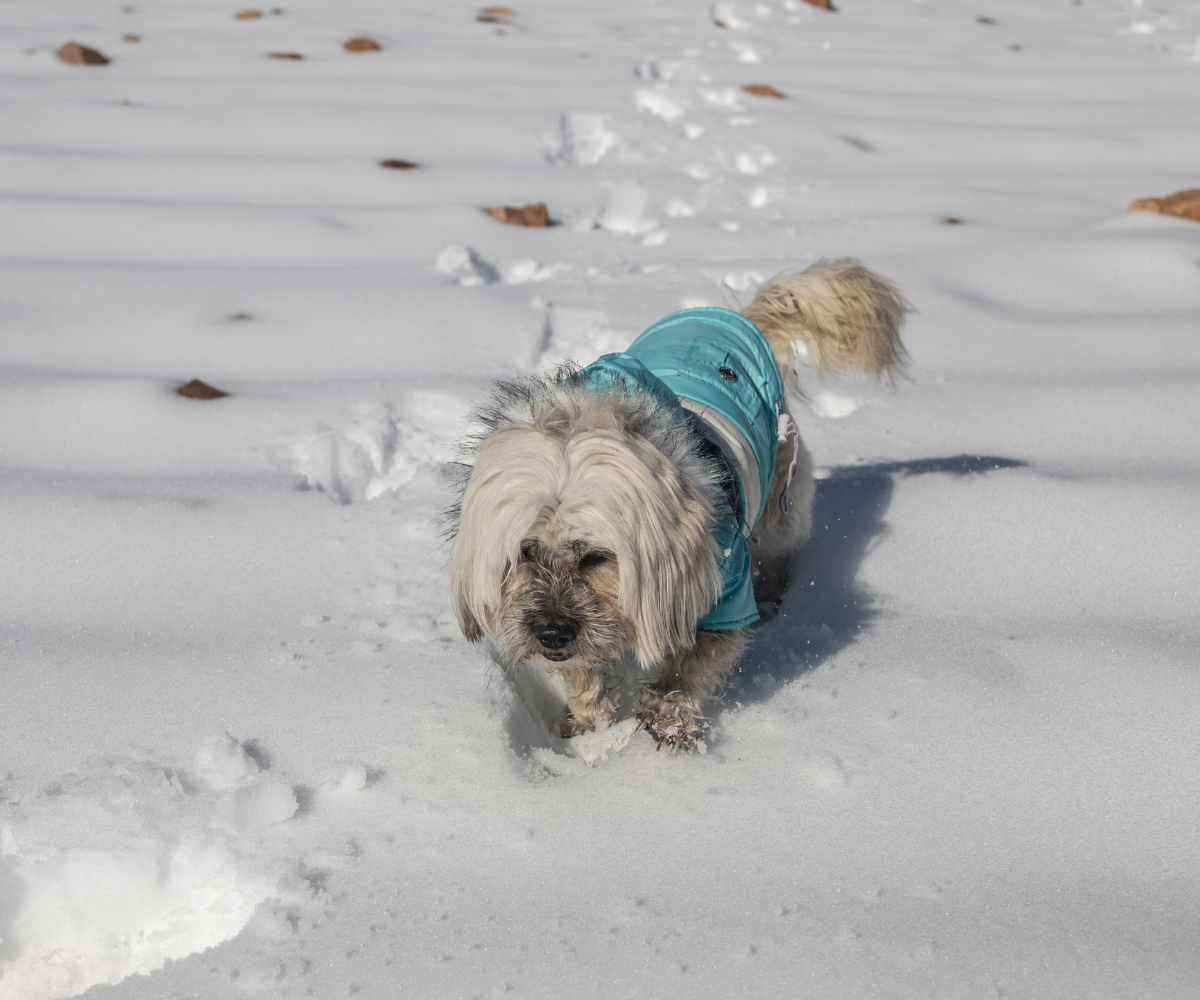Why Does My Dog Feel Cold? - Petfluence
Why Does My Dog Feel Cold? - Petfluence

Vet Reviewed

By: Sarah Hodgson
February 18, 2024
- Posted in Dogs
Table of Contents
Dogs are known for their warm and furry coats that keep them comfortable in all kinds of weather. However, even with their natural insulation, dogs can still feel cold, just like us humans. I
If you've ever wondered why your furry friend is shivering or seems uncomfortable in chilly weather, you're not alone. In this article, we'll go over how dogs feel the cold the same way we humans do even with all their fur.
Let's dive in!
Key Takeaways
Dogs can feel cold despite their natural insulation.
Signs that your dog may be feeling cold include shivering, lethargy, and seeking warmth.
Being too cold can be dangerous for your dog, so it's important to take steps to keep them warm and comfortable.
There are several signs that your dog may be feeling cold, including shivering, lethargy, and seeking warmth. It's important to pay attention to these signs and take steps to keep your dog warm and comfortable. In some cases, being too cold can be more than just uncomfortable for your dog - it can be dangerous.
What Are The Signs That Your Dog Is Cold?
When the temperature drops, it's important to keep an eye on your furry friend to make sure they are warm enough. Here are some signs that your dog may be feeling cold:
1. Shivering
Shivering is one of the most obvious signs that your dog is cold. Dogs shiver to generate body heat and keep warm. If your dog is shivering, it's a sign that they need to be warmed up.
2. Seeking Warmth
Dogs will often seek out warm spots when they are feeling cold. If you notice your dog lying in front of the fireplace or snuggling up to a warm blanket, it's a sign that they are feeling chilly.
3. Tucking Tail
When a dog tucks their tail between their legs, it can be a sign of fear or anxiety. However, it can also be a sign that they are feeling cold. If your dog is tucking their tail, it's a good idea to check their body temperature.
4. Curling up into a Small Ball
Dogs will often curl up into a small ball when they are feeling cold. This helps to conserve body heat and keep them warm. If your dog is curling up into a ball, it's a sign that they need to be warmed up.

5. Cold Ears and Paws
If your dog's ears and paws feel cold to the touch, it's a sign that they are feeling chilly. You can warm them up by rubbing their ears and paws or providing them with a warm blanket.
6. Whining or Vocalizing
Dogs may whine or vocalize when they are feeling cold. This is their way of communicating that they need to be warmed up. If your dog is whining or vocalizing, it's important to check their body temperature and provide them with warmth.
7. Change in Behavior
A change in behavior can be a sign that your dog is feeling cold. They may become lethargic, lose their appetite, or start coughing and sneezing. If you notice any of these signs, it's important to check their body temperature and provide them with warmth.
8. Extra Sleepy
Dogs may become extra sleepy when they are feeling cold. This is because their body is using energy to generate heat. If your dog is sleeping more than usual, it's a sign that they need to be warmed up.
What Are The Risks Of My Dog Being Too Cold?
When a dog is exposed to cold temperatures for an extended period, it can lead to various health risks. Here are some of the potential risks of a dog being too cold:
Hypothermia
Hypothermia occurs when a dog's body temperature drops below the normal range. This can happen when a dog is exposed to cold temperatures for an extended period. Symptoms of hypothermia include shivering, lethargy, and weakness. In severe cases, it can lead to organ failure and even death.
Frostbite
Frostbite is a condition where a dog's skin and tissues freeze due to exposure to cold temperatures. It typically affects the ears, tail, paws, and nose. Symptoms of frostbite include discoloration of the skin, swelling, and blisters. In severe cases, it can lead to tissue death and require amputation.
Respiratory Issues
Cold weather can also cause respiratory issues in dogs. When a dog breathes in cold air, it can cause the airways to constrict, making it difficult to breathe. This can lead to coughing, wheezing, and other respiratory problems.
Joint Stiffness and Pain
Cold weather can also cause joint stiffness and pain in dogs, particularly in older dogs or those with arthritis. The cold can cause the joints to become stiff and painful, making it difficult for the dog to move around comfortably.
Medical Concerns and Conditions
Dogs, like humans, are susceptible to a range of illnesses and infections, especially during the colder months. Some of the most common illnesses and infections that can cause dogs to feel cold include hypothermia, frostbite, and pneumonia.
If a dog is exhibiting symptoms of any of these illnesses or infections, it is important to seek veterinary care as soon as possible. A veterinarian can provide a proper diagnosis and treatment plan to help the dog recover.

Serious Health Conditions Related to Cold Symptoms
In some cases, feeling cold can be a symptom of a more serious underlying health condition in dogs. These conditions can include kidney disease, hypothyroidism, diabetes, and heart disease.
Kidney disease can cause dogs to feel cold due to a decrease in their body's ability to regulate temperature. Hypothyroidism can cause a dog's metabolism to slow down, which can lead to feeling cold. Diabetes can cause a dog to feel cold due to fluctuations in blood sugar levels. Heart disease can cause a decrease in blood flow, which can result in feeling cold.
Note
If a dog is exhibiting symptoms of feeling cold and also has other symptoms related to these health conditions, it is important to seek veterinary care immediately. Early diagnosis and treatment can help manage these conditions and improve the dog's quality of life.
What Temperature Is Considered Too Cold?
Dogs have a higher body temperature than humans, typically ranging from 100.5 to 102.5 degrees Fahrenheit. However, dogs can still feel cold when the temperature drops below a certain point. The threshold for what is considered too cold for a dog varies based on several factors, including the breed, size, coat type, and overall health.
For example, small dogs with short hair, such as Chihuahuas, are more susceptible to feeling cold than larger dogs with thick fur coats, like Siberian Huskies. Additionally, dogs with underlying health conditions, such as diabetes or hypothyroidism, may feel colder than healthy dogs.
Generally, if the temperature drops below 45 degrees Fahrenheit, it is considered too cold for most dogs. However, it is important to note that this is just a general guideline and not a hard and fast rule. Some dogs may be comfortable in colder temperatures, while others may start to feel uncomfortable when the temperature is still above 45 degrees Fahrenheit.
It is important for dog owners to pay attention to their dog's behavior and body language to determine if they are feeling cold. Signs that a dog may be feeling cold include shivering, hunching over, and seeking warmth by cuddling up to their owner or near a heat source.
How To Prevent My Dog From Being Cold?

Keeping your dog warm and comfortable is essential to ensure their well-being. Here are some tips to prevent your dog from feeling cold:
Appropriate Clothing and Shelter
Dogs with short hair or those that are small in size are more susceptible to feeling cold. Providing them with appropriate clothing such as sweaters or jackets can help keep them warm. However, it is essential to choose the right size and fabric to ensure that it fits well and does not cause discomfort.
Providing your dog with adequate shelter is also crucial. A doghouse with a roof and insulation can provide a warm and cozy space for your furry friend. Make sure that the shelter is dry, draft-free, and elevated off the ground to prevent cold and dampness from seeping in.
Veterinary Care and Medications
Regular visits to the veterinarian can help ensure that your dog is healthy and free from any underlying conditions that may cause them to feel cold. Certain medical conditions such as anemia, hypothyroidism, and diabetes can make dogs feel cold. Treating these conditions can help improve their overall health and prevent them from feeling cold.
In some cases, your veterinarian may prescribe medications to help regulate your dog's body temperature. However, it is essential to follow the prescribed dosage and instructions carefully to prevent any adverse effects.
By following these tips, you can help prevent your furry friend from feeling cold and ensure that they stay healthy and comfortable.
The Bottom Line
So there you have it, dogs can feel cold for various reasons, including age, breed, size, health conditions, and environmental factors. It is important for dog owners to monitor their pet's behavior and look for signs of discomfort or illness. Providing appropriate clothing, bedding, and shelter can help keep dogs warm and comfortable in colder temperatures.
Additionally, regular visits to the veterinarian can ensure that any underlying health issues are addressed promptly. Overall, understanding the reasons why dogs feel cold and taking appropriate measures can help ensure their well-being and comfort during colder winter months.
Frequently Asked Questions
What are the signs that my dog might be too cold?
Dogs that are too cold may shiver, have a decreased appetite, act lethargic, or seek out warm places to lie down. They may also curl up in a ball to conserve body heat.
How can I tell if my dog is cold at night?
If your dog is shivering or seeking out warm spots to lie down, they may be too cold. You can also check their ears, paws, and tail for signs of coldness. If they feel cold to the touch, your dog may be too cold.
What should I do if my dog is shivering and appears cold?
If your dog is shivering and appears cold, you should provide them with a warm and comfortable place to rest. You can also cover them with a blanket or provide them with a heated pad. If their symptoms persist, you should contact your veterinarian.
Are there any health concerns associated with my dog feeling cold?
Yes, if your dog is consistently feeling cold, it may be a sign of an underlying health issue such as hypothyroidism or anemia. If you are concerned about your dog's health, you should contact your veterinarian.
How can I ensure my dog stays warm inside the house?
You can ensure your dog stays warm inside the house by providing them with a comfortable and warm place to rest. You can also provide them with blankets or a heated pad. Additionally, you can adjust the temperature in your home to ensure it is warm enough for your dog.

Subscribe to Petfluence!
Get updates on the latest posts and more from Petfluence straight to your inbox.